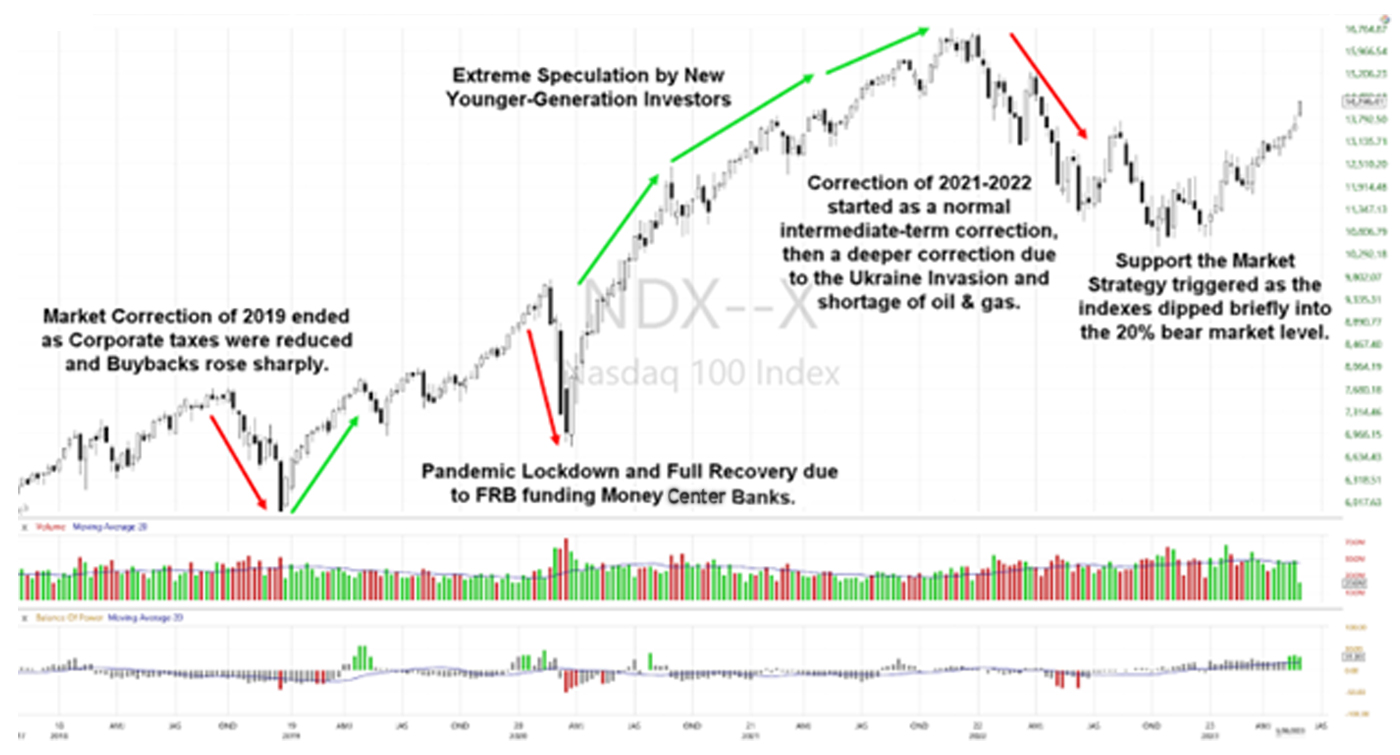
Pandemics create anomalies in business cycles, economic cycles, and the social order. All of this, in turn, impacts politics and governments. A “new normal” emerges from every pandemic.
This is also true for human endeavors, including the stock market.
When comparing global pandemics of the past to the most recent one, it becomes evident that once the anomalies of the pandemic subside and economies stabilize, an era of innovation emerges to solve the problems brought on by the pandemic.
In terms of the stock market, a shift occurred during the 2019 market correction that set the stage for developments during the pandemic and the new normal that emerged in the post-pandemic era.
As a former buy-side analyst with decades of experience in analyzing market behavior, I believe recent years have provided a fresh perspective on how large financial institutions are addressing the risk of market crashes. While the following commentary largely reflects my opinion, it is rooted in a deep “insider” understanding of buy-side behavior and actions.
A new way of managing the risk of market crashes?
In 2019, the largest buy-side institutions began discussing the significant risk taken on by new younger-generation investors who were buying exchange-traded funds (ETFs) instead of mutual fund investments.
ETFs are a derivative of the mutual fund and index fund industries. But mutual funds and index funds are generally bought as long-term investments, and redemptions may not be immediate. During stressed market conditions, redemptions could be delayed as long as six months. ETFs, on the other hand, can be sold immediately—just like a stock or any other tradable instrument.
To address this concern, the group of buy-side institutions formed a “preparedness system.” They had ample capital reserves on hand and the floor traders to do the work.
In February 2020, the pandemic hit and the market subsequently collapsed, as would be normal and natural. What followed, however, was highly unusual.
The Federal Reserve System, made up of 12 Federal Reserve banks and the governing board, stepped in far sooner than in prior market crashes. The Fed supported money center banks by buying bonds from them. The money center banks act as market makers as the market hits an extreme low. The money center banks can profit significantly during downtrends and stock market crashes. They buy stocks for pennies on the dollar and then wait to sell as the stock market recovers.
Following a severe crash, stocks typically experience some level of recovery. But this was the fastest bear market in history. Typically, a bear market has three legs down with brief bounces upward and usually lasts 1.2 years on average.
Since the money center banks were making the market, the buy-side institutions did not deploy what I call the “Support the Market system” at that time.
However, during the pandemic, more new younger-generation investors (funded, in part, by stimulus payments) entered the market using broker apps, like Robinhood, or other brokerages to buy and trade ETFs speculatively.
The speculation was rampant and far beyond fundamentals. The buy-side institutions saw a huge risk factor that could potentially cause a massive stock market collapse far more severe than the 2020 pandemic’s initial selling: What if those millions of inexperienced young investors holding ETFs became scared or worried and started selling their ETFs all at once?
The stock market would implode far worse than in March 2020. In less than one year, the market had become extremely speculative, and the pandemic was far from over.
Extreme gambling and speculation are followed by panic as prices collapse. An ETF rout of panic selling would put many institutions at risk of insolvency.
In 2022, when Russia invaded Ukraine, the “Support the Market” initiative was ready to go. The goal was not to stop a downward trend but to mitigate its impact on 401(k)s, mutual fund investors, and especially ETF investors. The goal was to support the index values to maintain them above the 20% bear market level.
When the market dropped a certain percentage, the orders to buy were automatically triggered. This level was far above where the banks would “make the market” by first selling short and then buying to cover.
Each index was targeted and monitored. If the index values fell below 20%, the “Support the Market” strategy triggered buys around that level. This process repeated several times, and ETF investors eventually stopped panicking. 401(k) holders saw a loss, but it was tolerable and did not cause them to move their money out of stocks. Mutual fund redemptions were minimal.
MARKET PARTICIPANT BEHAVIOR FROM 2019 TO 2023 (NASDAQ 100)
Sources: Martha Stokes, TechniTrader
The unusual strategy of the buy-side institutions worked. There was no official bear market in 2022. The indexes dipped into that level but did not go down further. Instead, it was an intermediate-term correction, necessary to adjust out the prior years’ speculation.
In the future, similar events may create a shallower correction and a much faster recovery. The NASDAQ 100 Index shows what happened graphically.
What this means for investors is the potential for fewer market crashes during stressed conditions and shallower, shorter bear markets in the future. This would be an unprecedented change to typical bull and bear market cycles.
The opinions expressed in this article are those of the author and the sources cited and do not necessarily represent the views of Proactive Advisor Magazine. This material is presented for educational purposes only.
 Martha Stokes, CMT, is the co-founder and CEO of TechniTrader and a former buy-side technical analyst. Since 1998, she has developed over 40 TechniTrader stock and option courses. She specializes in relational analysis for stocks and options, as well as market condition analysis. An industry speaker and writer, Ms. Stokes is a member of the CMT Association and earned the Chartered Market Technician designation with her thesis, "Cycle Evolution Theory." technitrader.com
Martha Stokes, CMT, is the co-founder and CEO of TechniTrader and a former buy-side technical analyst. Since 1998, she has developed over 40 TechniTrader stock and option courses. She specializes in relational analysis for stocks and options, as well as market condition analysis. An industry speaker and writer, Ms. Stokes is a member of the CMT Association and earned the Chartered Market Technician designation with her thesis, "Cycle Evolution Theory." technitrader.com




